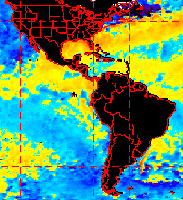|
NOAA Magazine || NOAA Home Page EL NIÑO EXPECTED TO DEVELOP BY YEAR'S END
NOAA's Climate Prediction Center states that El Niño is still developing and will probably remain that way for the next several months, with abnormally warm ocean surface temperatures continuing over most of the central equatorial Pacific. "Some events develop quickly and others, like this one, have a more gradual evolution," said Brig. Gen. Jack Kelly USAF (ret.), director of NOAA's National Weather Service. "We are maintaining a constant watch over the conditions of the atmosphere and ocean and will continue providing guidance on potential impacts," said Kelly. In this month's El Niño/Southern Oscillation Diagnostic Discussion, NOAA scientists report that ocean surface temperatures were more than 0.5 degrees C (0.9 F) above average during April over a large part of the central equatorial Pacific and as much as 2 degrees C (3.6 F) above average in the extreme eastern equatorial Pacific. Also, subsurface ocean temperatures remained more than 2 degrees C (3.6 F) above normal in the central equatorial Pacific. NOAA will continue monitoring El Niño's developments and provide monthly updates. The El Niño/Southern Oscillation Diagnostic Discussion is a team effort consisting of the Climate Prediction Center (lead), Climate Diagnostics Center, Geophysical Fluid Dynamics Laboratory, National Climatic Data Center, Atlantic Oceanographic and Meteorological Laboratory, and the International Research Institute for Climate Prediction. NOAA's Climate Prediction Center is an organization of the National Weather Service. NOAA's National Weather Service is the primary source of weather data, forecasts and warnings for the United States and its territories. The National Weather Service operates the most advanced weather and flood warning and forecast system in the world, helping to protect lives and property and enhance the national economy. Relevant Web Sites ENSO Frequently Asked Questions Sea Surface Temperature Outlook ENSO Impacts by Region
|
